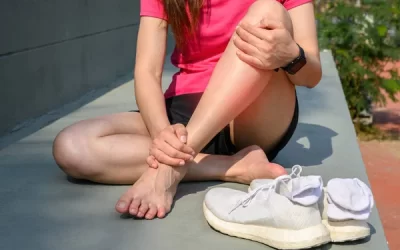Relaxation Exercises to Help Combat Stress
In my thirty-six years of physical therapy practice, I have often had patients come to me with this question, “My doctor told me that I need to reduce the stress in my life. Do you know of any exercises I can do to relax more?” I certainly have some professional advice to share. I also have enough personal experience with stress to understand as well. You see, we are all human and life is stressful. Yes, even physical therapists struggle with stress. I have seen and treated many places on the human body where stress can physically manifest itself from headaches, jaw (TMJ) problems, neck pain and muscular trigger points to even some kinds of low back pain. Ask a roomful of people in what way they experience stress and some will say “tension headache”. Still others are “gut reactors” and they have stomach aches or GI distress. Still others describe feeling “tired and aching all over.”
Stress is unavoidable. Our ancient ancestors had to worry about finding food to eat and whether what they were hunting was going to turn around and start to hunt them! They did not stress over rush hour traffic, the kids overscheduled lives or the looming work deadline but they did have stress. The problem is that although our civilization has greatly evolved since those days, our human physiology is still the same. We are wired for the “fight or flight” response to stress. Our adaptive response to stress remains primitive. This system was highly effective for the ancient “life or death” scenarios and is still our best bet if facing a life or death situation. Our problem is that it activates on many levels of modern life experience and sometimes it never seems to stop as we encounter one stress after another.
Our modern life is highly complex. We are all under much pressure these days from economics, family and work responsibilities, concerns about children or aging parents and keeping up with the ever changing technologies that impact our lives. We are in a hurry up world and feel we need to be doing ten things at once just to get through our days. It is culturally acceptable to be literally wired and plugged into many media sources at once. “Multi-tasking” is the name of the game in our world. If we don’t keep up, we feel like we are falling more and more behind. We expect our neurologic system and other body systems to just shift into high gear and keep moving along with us. Sooner or later, our body begins talking back to us in terms of physical symptoms, or mental feelings of being overwhelmed/anxious, sad or depressed.
How do we effectively handle this reality of modern life? How do we cope with stress? In some ways this “coping” can be the way we “fight or flee” from stress. We need to develop methods of overcoming the response. We have to begin to recognize that we must develop new ways of reacting to modern life situations.
So, here are some of my suggestions to help reduce stress and relax more:
Breathing/Breathing as a Relaxation Exercise: One of the easiest physical skills to reconnect ourselves to is the ability to take to a proper breath. It seems crazy to some people –“Don’t I breathe all the time? How is there a right way to breathe?” During each day, you breathe about 25,000 times, over and over again. In our hurried lifestyles, many persons are running around doing sub-maximal breathing – upper chest breathing. Taking shallow sips of air versus deep replenishing breaths. We often do not breathe deeply into our diaphragm which enables our lungs to be fully inflated – a belly breath. When we do upper chest breathing, we use many accessory muscles to breathe – muscles that attach to our neck, our collarbones/shoulder joints. Tension and fatigue in these muscles can lead to pain, tension and postural changes in our neck and torso. Short, hurried breaths can make you feel anxious. Oxygen is so vital to all of our tissues – the more efficiently we breathe, the better overall the tissues of our body will be. Getting rid of carbon dioxide is equally important. Our breathing touches all of our body systems. Smokers often have delayed healing times due to the fact that their body is not getting normal oxygen content. If you smoke, please consider changing your habit. For chronic upper chest breathers, a mindful switch to deeper breathing may make a big difference.
Here is how you can tell how you are breathing and use breathing as a relaxation exercise:
Sit up in a chair or lie down on your back. Place one hand over your chest bone (sternum) and the other hand on your belly button (abdomen). Breathe. Try to gain a sense of which hand is moving more. If the one on your chest is, you are doing upper chest breathing. If the one on your stomach is, you are doing good abdominal breathing.
Practice breathing deeply enough that you get that deep belly breath going. Once you get the hang of it, try adding longer times to inhale and exhale. “I breathe in for 1,2,3,4,5 full seconds. I breathe out for 1,2,3,4,5 full seconds.” Try to get into a rhythm with it. As a relaxation exercise, do this 2 to 3 times per day for 1-3 minutes at a time. Go to this exercise when you begin to feel stress take its first sling at you. It is easy enough to do at a work desk, in the car at a long traffic red light, sitting waiting for your child’s dance class or sports practice to finish, even while standing rinsing dishes. Lastly, you can add some positive reinforcement to calm your racing mind. Try breathing in while telling yourself, “My body is calm.” Then, while releasing your breath, tell yourself, “My body is quiet.” Also be mindful to breath through your nose. This pathway filters germs and toxins and humidifies the air taken in. It is also estimated to draw in 20 percent more oxygen and helps to boost nitric oxide intake which helps to relax blood vessels, letting oxygen get where it is needed faster.
Stretch/Stretching for relaxation
Tension causes us to hold ourselves “tight”. Muscles contract, jaws clench, teeth grind, posture contracts, skeletal systems stay in bent positions and cause pain. As we age, our connective tissues are known to become less fluid, less pliable, rigid. Some diseases like diabetes also cause changes in soft tissues of muscles and tendons creating a less flexible musculoskeletal system. We must all counteract these changes with gentle stretching. A physical therapist is able to evaluate which areas on your body are not demonstrating normal muscle length or flexibility and contributing to postural changes and possible pain. For the general population, we would like you to know which muscle groups tend to be the tightest overall due to our modern life. We live in a world which is both sedentary but fast paced. We sit a great deal – in our cars, at our job, at school, watching TV at night, at our computers or playing video games. From a posture standpoint, we tend to hold our head and neck forward over our torso instead of balanced up over the center of it. Our upper spines become more rounded. Our hip flexor muscles get tight in front of our pelvis from sitting so much, hamstring muscles behind our knee and calf muscles in our lower legs also get used to being in shortened positions. You should learn the proper way to stretch all of these problem areas. Keep in mind that stretch is to elongate a muscle, not to tear it. Stretching should be gentle not forced. No “bouncing” while holding a stretch. It should be done over a long length of time (holding a stretch for 15 to 30 full seconds) but you only need to do 1-3 repetitions per tight muscle to begin to see the benefit. From a posture standpoint, unless your condition prohibits it, laying on your stomach for a short period of time (5 min-10 min) each day can counteract the usual postural positions we put ourselves into each day. Study your body and listen to it – what muscles are telling you that they hurt? Stretch and you will find that you carry yourself better and move with more range of motion and less muscle tension.
Sensory fasting: a relaxation exercise
When you feel anxious or overwhelmed, sometimes another thing you can do is to take a fast from information overload. Our brains are remarkable processors but they can only handle so much at a given time. Sometimes in times of stress we need to dial down the sensory input we are trying to process. Turn off the radio and TV. Spend a short while in the quiet. You can still drive without listening to argumentative radio programs or loud music. Switch the music you listen to on your commute. Give your brain some classic music from a classical music station, or use nature sounds like birdsong or waterfall/rain, sounds of the woods CDs or downloads, or just drive without extra sound. Take a day to fast from technology – your Facebook page will still be there tomorrow, you can check for phone messages after you do your breathing exercises during an intense moment – your phone does not have the right to interrupt the relaxation moment you are giving yourself. Try to have a dial down time built into your day even if it is just 10 to 15 minutes. Give yourself a chance to do one thing at a time as often as you can. (Not always feasible but do it when you can).
Walking
If you can only do two things to relax, I would recommend the breathing activities and building in walking into your day. A 10 to 15 minute walk after dinner would be great but you can sneak walking into your day in many ways: park farther than you usually do in the work or store parking lot, opt for the stairs instead of the elevator, if your child has practice at the school – throw your walking shoes into the car and walk the track or school campus while you wait for them, making a phone call? – take a walk while catching up with a friend on the phone. Walking helps because it exercises multiple muscles, it is cardiovascular exercise and when done outdoors, connects us to nature which can take our minds off our problems for a little while.
I hope that some of these suggestions may prove helpful to you. We at Optimal Physical Therapy and Sports Performance would be happy to discuss any of these options with you in more depth if you like. Our goal is to contribute to optimal health for you. We are available for consultation on postural concerns, muscle tension evaluation, proper stretching training, proper fitness for both healthy individuals and those facing chronic medical conditions as well as rehabilitation after injury or illness. All of our therapists are direct access licensed – no prescription needed.



